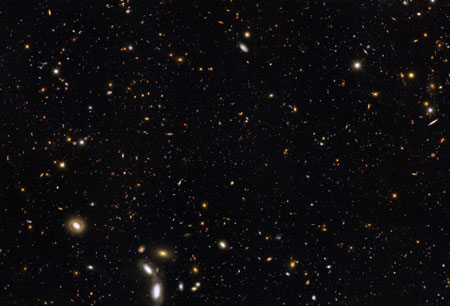
(photo courtesy of NASA)
Earlier this month, NASA released this breath-taking image seen above which reveals 12 billion years of cosmic history. What makes it visually stunning is the fact that those bright spots are not stars, but thousands of galaxies in various stages of growth and development (click here to see a HD version of this picture, courtesy of NASA).
For those of you who might not be familiar with astronomy, it might sound weird that this one photograph could show 12 billion years of our universe’s history. That is, until we figure in just how big the universe is. To understand this better, let’s first consider the fact that light travels at a constant speed of 300,000 km/sec – it can’t speed up or conversely, slow down. As such, the bigger the distance between a light source – like a star or galaxy – and Earth, the longer it will take the light from that source to reach our planet.
In the case of this photograph, the light from the galaxies that we see in the foreground actually left that galaxy about 1 billion years ago, while those reddish glows fading into the background represents light that was emitted by distant galaxies almost 12 billion years ago and which only now has reached our part of the universe.
With its references to time spans in the billions of years and distances that go from millions of kilometers out to infinity, astronomy can certainly challenge
us in how we grasp concepts on such a large scale. At the same time, though, there’s a great lesson to be learned here about the importance of taking a few steps back in order to understand how things relate to one another.
It’s a common occurrence for us to find ourselves prioritizing efforts to complete a specific project, or putting more resources in an attempt to resolve a lingering problem. It’s a reasonable enough approach as sometimes the key to successfully reaching an objective is by putting all our focus into that one goal (think of how Lance Armstrong trains and competes in the Tour de France races). Where problems can arise, though, is when we become so focused on the details that we start to lose perspective on how it fits into the bigger picture.
In this photograph of the cosmos, we can see that in addition to those galaxies seen so clearly in the foreground, there is much to be gained and learned by examining those objects just on the boundaries of our perception. The same, of course, applies to how we approach both our businesses and our lives. In those cases, it’s a matter of striking a balance between focusing on the things we consider to be important, while at the same time keeping our eyes open to the potential insights and ideas that can be provided by those blurry objects found just on the limits of our periphery.
